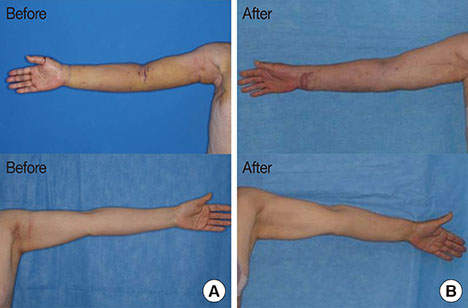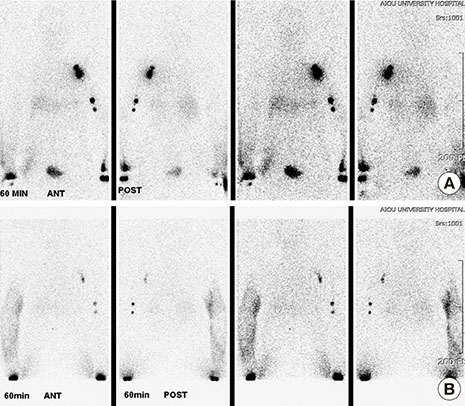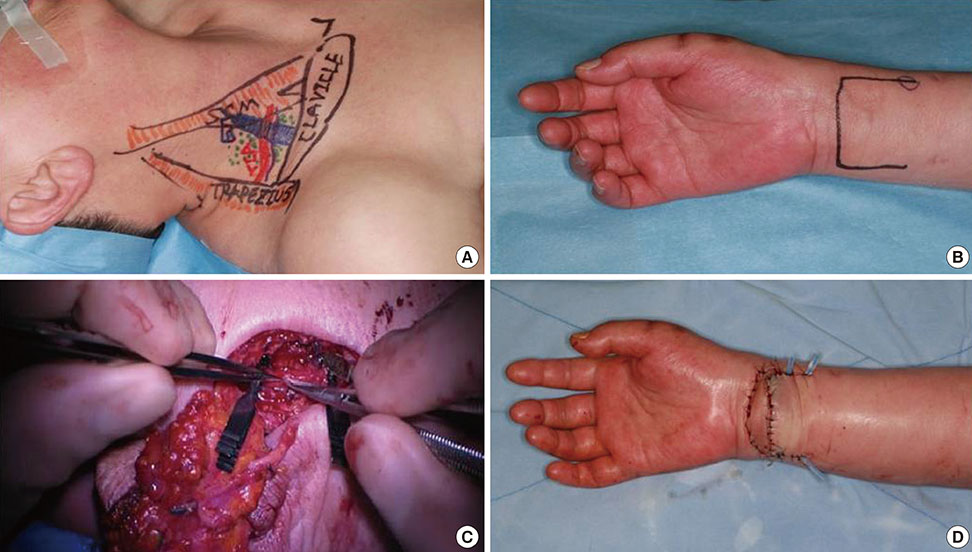J Breast Cancer.
2016 Mar;19(1):92-95. 10.4048/jbc.2016.19.1.92.
Vascularized Free Lymph Node Flap Transfer in Advanced Lymphedema Patient after Axillary Lymph Node Dissection
- Affiliations
-
- 1Department of Plastic and Reconstructive Surgery, Ajou University Hospital, Ajou University School of Medicine, Suwon, Korea. i00325@live.co.kr
- 2Department of Surgery, Ajou University Hospital, Ajou University School of Medicine, Suwon, Korea.
- KMID: 2176327
- DOI: http://doi.org/10.4048/jbc.2016.19.1.92
Abstract
- Lymphedema is a condition characterized by tissue swelling caused by localized fluid retention. Advanced lymphedema is characterized by irreversible skin fibrosis (stage IIIb) and nonpitting edema, with leather-like skin, skin crypts, and ulcers with or without involvement of the toes (stage IVa and IVb, respectively). Recently, surgical treatment of advanced lymphedema has been a challenging reconstructive modality. Microvascular techniques such as lymphaticovenous anastomosis and vascularized lymph node flap transfer are effective for early stage lymphedema. In this study, we performed a two-stage operation in an advanced lymphedema patient. First, a debulking procedure was performed using liposuction. A vascularized free lymph node flap transfer was then conducted 10 weeks after the first operation. In this case, good results were obtained, with reduced circumferences in various parts of the upper extremity noted immediately postoperation.
Keyword
MeSH Terms
Figure
Cited by 1 articles
-
Effects of Exercise on Breast Cancer-related Upper Extremity Lymphedema in Breast Cancer Survivors: A Systematic Review and Meta-analysis
Jaewon Park, Miran Jung
Korean J Adult Nurs. 2019;31(5):461-478. doi: 10.7475/kjan.2019.31.5.461.
Reference
-
1. Murdaca G, Cagnati P, Gulli R, Spanò F, Puppo F, Campisi C, et al. Current views on diagnostic approach and treatment of lymphedema. Am J Med. 2012; 125:134–140.
Article2. Karri V, Yang MC, Lee IJ, Chen SH, Hong JP, Xu ES, et al. Optimizing outcome of Charles procedure for chronic lower extremity lymphoedema. Ann Plast Surg. 2011; 66:393–402.
Article3. Sapountzis S, Ciudad P, Lim SY, Chilgar RM, Kiranantawat K, Nicoli F, et al. Modified Charles procedure and lymph node flap transfer for advanced lower extremity lymphedema. Microsurgery. 2014; 34:439–447.
Article4. O'Brien BM, Khazanchi RK, Kumar PA, Dvir E, Pederson WC. Liposuction in the treatment of lymphoedema: a preliminary report. Br J Plast Surg. 1989; 42:530–533.5. Granzow JW, Soderberg JM, Kaji AH, Dauphine C. Review of current surgical treatments for lymphedema. Ann Surg Oncol. 2014; 21:1195–1201.
Article6. Chang DW, Kim S. Breast reconstruction and lymphedema. Plast Reconstr Surg. 2010; 125:19–23.
Article7. Granzow JW, Soderberg JM, Dauphine C. A novel two-stage surgical approach to treat chronic lymphedema. Breast J. 2014; 20:420–422.
Article8. Cheng MH, Chen SC, Henry SL, Tan BK, Lin MC, Huang JJ. Vascularized groin lymph node flap transfer for postmastectomy upper limb lymphedema: flap anatomy, recipient sites, and outcomes. Plast Reconstr Surg. 2013; 131:1286–1298.
Article9. Lin CH, Ali R, Chen SC, Wallace C, Chang YC, Chen HC, et al. Vascularized groin lymph node transfer using the wrist as a recipient site for management of postmastectomy upper extremity lymphedema. Plast Reconstr Surg. 2009; 123:1265–1275.
Article
- Full Text Links
- Actions
-
Cited
- CITED
-
- Close
- Share
- Similar articles
-
- No-fat diet for treatment of donor site chyle leakage in vascularized supraclavicular lymph node transfer
- Management of Malignant Melanoma Using Sentinel Lymph Node Biopsy: A Case Report
- Surgical treatment of lymphedema
- Ultrasonography for Staging Axillary Lymph Node in Breast Cancer Patients
- Patient-specific surgical options for breast cancer-related lymphedema: technical tips




